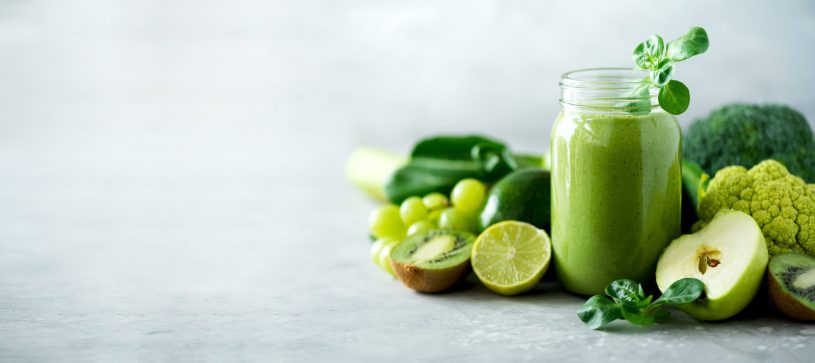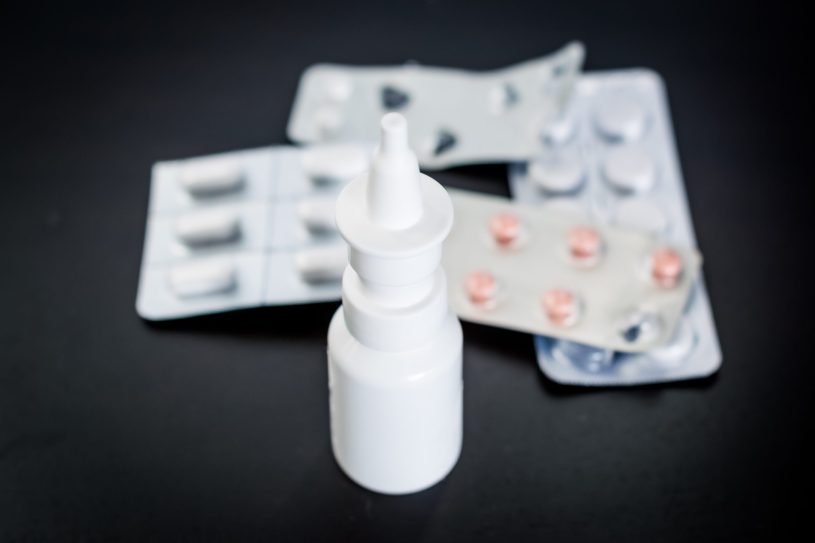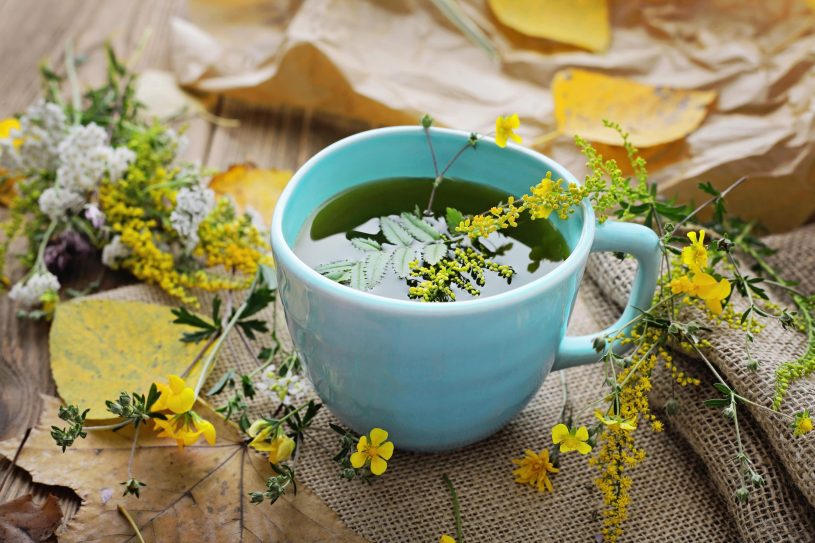What are antihistamines? They are substances that block the release or action of histamine. It is a protein released by our body in response to allergic stimuli and triggers allergy symptoms like sneezing and itchy eyes and throat and sometimes fever. There are synthetic and naturally occurring antihistamines that can help in the management of allergies. While synthetic drugs are potent and well-known pharmaceutical agents, they are not without risks. These risks include brain fog, drowsiness, rapid heart rate, dry mouth, and dizziness.
Table Of Contents:
- How Does Natural Antihistamine Work?
- What Are Some Naturally Occurring Antihistamines?
- What Foods Are High in Antihistamines?
- How to Manage Allergy Symptoms?
- What Are Some Over-The-Counter Antihistamines?
- Are Antihistamines and Decongestants Same?
- What Are the Similarities Between Antihistamines and Decongestants?
- What Are the Differences Between Antihistamines and Decongestants?
- Which One Is More Effective in Treating Allergy? Antihistamines or Decongestant?
- Is Combining Antihistamines and Decongestants Safe?
- What to Use for Relief From Cold-Antihistamines or Decongestants?
- What Are Safer Alternatives to Anti-allergy Meds?

Natural antihistamines are herbs and foods that mimic the effects of well-known pharmaceutical drugs on histamine production without the discomforting adverse reaction. These adverse reactions do not typically occur when using natural antihistamines. In this article, the discussion is going to be about how one can try to minimize potential health risks of pharmaceutical drugs with organic alternatives and when one should contact health professionals.
How Do Natural Antihistamines Work?
Allergies are a highly prevalent disease worldwide. 1 in every 8 children suffers from asthma worldwide. In the US, it is considered the 6th leading cause of chronic health disease. It is estimated that 41.7% of adults suffer from allergies. The annual number of Americans suffering from different allergies exceeds 60 million.
Allergy is a type 1 hypersensitivity reaction. It is a type of immune response to particular environmental stimulants. These stimulants vary for each individual and include dust, pollens, smoke, certain foods, or insect bite. These stimulants are also known as allergens. Allergic reactions are active immune responses against these allergens by Immunoglobulin E-mediated mechanisms. They are primarily responsible for the body’s hypersensitivity reaction.
Allergens trigger the immune cells in connective tissues, also known as mast cells, to release histamines. Histamines are inflammatory substances that cause inflammation and increased blood flow to various body parts. Inflammation gives rise to the myriad of allergic reactions commonly experienced, such as sneezing, sore eyes, rashes, runny nose, and overall discomfort, which can be relieved by natural antihistamine or prescription drugs.
Antihistamines, in general, inhibit the release or the effects of histamine in the body. There are synthetic and natural Anti Allergies. Like all other drugs, they are not completely safe for one’s health. One of the most common adverse effects of OTC antihistamines is a drug interaction. Intake of these drugs requires precaution. For instance, taking an antihistamine and alcohol mixture is a dangerous combination. Food and drinks generally do not affect the medication, but other drugs and substances can worsen its adverse reactions.
Prescription and over-the-counter antihistamines are efficient and quick, but the adverse effects compel people to try safer and better alternatives with maximum efficacy like antihistamine herbs.
Few studies have been conducted on the comparison between natural and pharmaceutical antihistamines in terms of effectiveness. Also, it is essential to note that natural antihistamine supplements, sourced from either herbs or foods, are not created equally. Therefore, each employs different mechanisms that determine its effectiveness. One should contact a doctor for an appropriate alternative to synthetic medicine.

Naturally-Occurring Substances That Fight Allergies
Many naturally occurring substances can relieve allergy symptoms. Some of them work as antioxidants to reduce the severity of allergy while others interfere with mast cells to inhibit histamine release. These substances include vitamin c, bromelain, stinging nettle, probiotics, butterbur, and N-acetyl Cysteine. While they are all effective drugs, their efficacy varies for every individual depending on the metabolism, previous health conditions, and other interactive factors.
Following are some effective naturally occurring substances that can help relieve allergy signs along with their mechanism of action and how they can be better antihistamines alternatives.
Vitamin C
Many people wonder if Vitamin C is a natural antihistamine? Yes, Vitamin C is a water-soluble vitamin that provides nourishment to the body. Its potency as an antioxidant helps prevent cell damage, fight infections, alleviate fever, and reduce allergy severity.
Bromelain
Bromelain, an enzyme that is naturally found in pineapples, is also available as a supplement. Numerous research studies have proven bromelain as the best natural Anti Allergy for allergic rhinitis as it assists in solving respiratory distress and reducing inflammation.
Quercetin
Quercetin is one of the best natural antihistamine substances. Most products, like garlic, contain the antioxidant quercetin. It interferes with the histamine response of the body by inhibiting mast cells, thus pacifying asthma symptoms and inflammation.
It is available as a supplement, but quercetin-rich foods are healthier additions to an anti- allergy diet.
Stinging Nettle
The leaf of this natural antihistamine can bring down the effects of hay fever. It has anti-inflammatory properties that can help relieve symptoms of sneezing, itchy eyes, and runny nose. The leaves are turned into natural antihistamine tea to remove the hair-like barbs that can cause irritation. These decongestant arbs contain chemicals like leukotrienes, histamine, formic acid, and acetylcholine that may trigger rashes and bumps.
Probiotics
Probiotics improve the digestive system. They also help the body adjust to foreign substances introduced into the system. Having a balance of good bacteria can strengthen an individual’s immune response when exposed to common allergic triggers. Probiotic-rich drinks and supplements are widely available in the market.
Butterbur
One of the most useful natural antihistamine herbs is butterbur. It is rich in extracts that can cure migraines and relieve cramps, allergies, asthma, hay fever, and coughing fits. While the mechanism of action of butterbur is unknown, it is thought to exert its effect by blocking the release of histamine and leukotrienes thus reducing inflammation and allergy symptoms.
N-Acetyl Cysteine
While many are choosing between decongestant vs antihistamine for allergy relief, some organic products can do both. N-Acetyl Cysteine is a natural antihistamine, but its supplement form can also help unclog the congestion that resulted from allergies, infections, or chronic illnesses.
Foods High in Antihistamine to Fight Allergies
Nature has its own way of curing disease and promoting health. Herbs and foods are used for generations for the treatment of ailments due to their immune-boosting and anti-inflammatory properties. Below is a comprehensive natural antihistamine alternatives food list consisting of herb antihistamines, vegetables, and fruits which can be a perfect organic alternative.
All Natural Foods in the List Are Common Antihistamines and Can Repress Inflammation and Equalize Mast Cells:
- Watercress: Watercress has a lemon-like and pepper-like taste. Known for being highly nutritious, it is also one of the best natural antihistamine foods. It can prevent 60% of histamines that were released by mast cells during an allergic reaction.
- Garlic: Garlic is a common natural antihistamine food. Garlic possesses antioxidants and probiotics that stop mast cells from releasing histamine.
- Moringa: This is one of the essential superfoods and natural antihistamine herbs. Compared to watercress, it can inhibit 12% more of all the histamines released by mast cells.
- Aloe Vera: A natural antihistamine for the skin that is abundant in vitamin E. It boosts the body's health and It helps reduce itch caused by hives and prevents contact dermatitis.
- Peppermint: It contains flavonoids that are potent inhibitors of histamines. Traditionally, it has been used as an H2 blocker. Its oil version is considered one of the few and most effective Anti Allergy essential oils. Most people use it as a natural topical Anti Allergy when diluted with a carrier oil. Others prefer diffusion therapy.
- Oatmeal: Oatmeal is one of the commonly-used natural antihistamine foods for hives, but not by ingestion. Oatmeal baths can quickly soothe pain and itching caused by allergies.
- Ginger: Ginger’s natural antihistamine effects come from its ability to stabilize mast cells. It has been known to prevent allergic reactions since the early days.
- Turmeric: It has potent antioxidant and anti-inflammatory properties, making it the best natural antihistamine for hives. Both fresh and frozen rhizomes can be easily integrated into numerous dishes.
- Apples: Apples contain flavonoids and polyphenols that can prevent histamine release. Most of these nutrients come from the apple’s skin.
- Pomegranates: They are rich in vitamin C, tannins, and anthocyanins. They contain potent antioxidants that are even greater than green tea. These properties render this sweet and tangy fruit a natural antihistamine for allergies. Knowing how much vitamin C induces natural antihistamine effects is assistive when consuming fruits rich in it.
In contrast to using anti-allergy medications, regular consumption of these foods will not lead to the overdose of the drug and tolerance. It is highly recommended to try to incorporate them into one’s diet, not only for their anti-allergy effects but also for their beneficial nutrients.
However, some of them can cause allergies as well – so make sure to check the health condition regularly and contact the doctor if the condition worsens.
Allergy Therapeutic Option
Some people are concerned about the possibility of developing antihistamine addiction to using common antihistamines. Even over-the-counter antihistamines have the potential for addiction. Using natural antihistamines can be helpful for individuals with mild allergies and an excellent adjunct to treatments intended for more aggressive conditions. Unfortunately, for severe cases, medical interventions and other several precautions must be taken.
While many can benefit from water, salt antihistamine, and other foods, patients who are suffering from antihistamine anxiety, may require avoiding allergens and immunotherapy.
Avoiding Allergens
Avoiding allergens may sound simple and sensible, but several steps need to be taken to figure out what is causing one’s allergic reactions. Environmental interventions need to be observed. The patient has to be evaluated first and foremost for the type of allergy based on their history. In addition to avoiding foods that may aggravate an anaphylaxis reaction, other environmental exposures to allergens are also checked. It can be done by a thorough examination of the house, workplace, school, and other regularly visited places which may have environmental allergens. Once trigger factors are detected, intervention strategies are recommended for hay fever and allergies.
Immunotherapy
Immunotherapy is the process of introducing allergen contact and increasing doses of an allergen gradually to the allergic person. The immune system can be desensitized to specific triggers that cause allergic symptoms. Initially, the patient will be tested for trigger factors. Symptoms may decrease during the initial stages of treatment, but it may take a full year to notice a more drastic improvement. If successful, the treatment should be maintained for three to five years.
Over-The-Counter Antihistamine Drugs for Allergy
In general, there is no treatment for allergy but there are several Over-the-counter antihistamines and prescription medications that can help one with the allergy. There are very common antihistamines. They can lessen the severity of runny noses, watery eyes, and other irritating signs. These drugs include antihistamines, decongestants, nasal sprays, and corticosteroids.
Some of the Over-The-Counter Antihistamine Drugs Are:
| Generic name | Brand name | Formulation | Precautions |
| Cetirizine | Zyrtec | Chewable tablets, syrup, rapidly dissolving tablets | Can cause stomach pain, drowsiness, and dry mouth. Severe adverse reactions are rare. |
| Fexofenadine | Allegra | Chewable tablets, syrup, rapidly dissolving tablets | Don’t take with fruit juices, take with water and on empty stomach. |
|
Diphenhydramine |
Benadryl | Tablets, capsule, liquid form | Not suitable for children under 6 years of age. Don’t use it in the common cold. Can cause serious adverse reactions. |
| Loratadine | Alavert, Claritin | Chewable tablets, syrup, rapidly dissolving tablets. The dosage depends on age. | Don’t take more than the recommended dose. Contact the doctor if any adverse reaction occurs. |
This table has been made available for informational and educational purposes only. Consult with a doctor or healthcare professional.
While over-the-counter antihistamines availability means they are safe and free of severe adverse reactions, there are still adverse reactions that can manifest upon drug use. This is why self-medication is prohibited by professionals.
They can cause severe adverse reactions if used more than the directed dosage or used for children under 6 years of age without doctor consultation. It is necessary to contact health professionals before taking any medication for allergy to minimize adverse reactions and try to monitor any severe reaction which may need immediate medical attention.
Antihistamine vs Decongestant: Are Antihistamines and Decongestants the Same?
Antihistamine vs decongestants: Although both drugs are used in the treatment of a common group of illnesses (colds, allergies), both drugs are not the same. The drugs have different modes of action and produce different results but are often mistaken for each other because they produce a few similar results.
What does an antihistamine do? As the name implies, this group of drugs works by inhibiting the actions of a chemical called histamine. Histamine is released during an allergic reaction. In a person who is allergic to a particular agent; dust, pollen, fumes, etc., re-exposure to the allergen causes the immune cells to stimulate the release of histamine. Histamine produces the effects of allergies such as a runny nose, nasal congestion, nasal itch, and teariness of the eyes.
Antihistamine foods, such as bell peppers, broccoli, red wine, and citrus fruits also produce a similar result. These foods have antihistamine agents and may be used as natural antihistamine alternatives for home remedies.
Decongestants, on the other hand; and as the name implies, decongest the nostrils, sinuses, and airways which are clogged with mucus when one has colds and signs of flu. These drugs work by constricting blood flow in these areas, consequently reducing mucus production. This allows mucus to drain correctly.
Antihistamines manage the allergy by blocking off the pathway setting the chain while decongestants provide symptomatic treatment for the nasal. While decongestants are an effective medicine to reduce irritating post nasal drip and runny nose, they can’t manage the ocular, and dermal reaction. They are the go-to medicines for that. Contact the medical professionals for proper OTC antihistamines or prescription medication.
Similarities Between Nasal Decongestants and Antihistamines
Similarities in antihistamine vs. decongestants are a widely debated topic. Nasal decongestants and Anti Allergy are both reliable medicines for the treatment of allergy symptoms. Most of these drugs are available as OTC antihistamines for immediate management. While nasal decongestants and antihistamines are different in the mechanism of action there are still functional similarities which makes them ideal for relieving symptoms of runny nose, itchy eyes, and sneezing.
Both Classes Are Drugs Are Alike in a Few Ways:
- Uses: Both antihistamines and decongestants can be used in the treatment of colds, allergies, and flu. While decongestants may provide relief of nasal congestion and breathing problems, Anti Allergy takes care of those and the other symptoms including runny nose, sneezing, watery eyes, nasal and eye itch, and postnasal drip.
- Formulations: Both drug classes are available in the same formulations; as oral drugs, nasal sprays, eye drops, and are contained in several expectorants.
- Contraindications and complications: Anti-allergy and nasal decongestants have similar contraindications; Both classes of drugs should be avoided by individuals who have high blood pressure, an overactive thyroid gland, enlarged prostate, and heart disease.

Differences Between Antihistamines and Decongestants
How would one recognize the difference in antihistamine vs decongestants? What is the difference between a decongestant and an antihistamine? Though both are thought of as similar, these two classes of drugs have a lot of differences.
These Are Outlined in the Table Below:
| Differences | Decongestants | Antihistamines |
| Mode of Action | Decongestants work by constricting the blood vessels, thereby reducing fluid buildup in the nostrils and airways. | These work by blocking the working of histamine. This not only includes the nasal and airway congestion but other allergy symptoms |
| Effects | Provide relief only from nasal and airway swelling and congestion in colds. | Produce relief of other symptoms of colds and allergies other than nasal congestion; such as cough, runny nose, teary eyes, red eyes, sneezing, as well as itchy nose and eyes. |
| When to Take Antihistamine vs. Decongestants | Used typically for relief from colds and nasal allergies. | Used for all types of allergies, not just nasal allergies. |
| Risk of Rebound Symptoms | Prolonged use (more than 3-5 days) causes the symptoms to rebound, in a condition called rhinitis medicamentosa. | Do not cause rebound cold symptoms. (But what happens if one takes too much antihistamine? It may cause fast heart rate, cardiac arrest, and in severe cases, death.) |
| Prophylaxis | These can not protect from symptoms if used before the onset of symptoms. | Oral antihistamines can prevent allergic symptoms if taken before the onset of symptoms. |
| Use in Breastfeeding | Decongestants such as phenylephrine and pseudoephedrine can reduce breast milk so should be avoided. | Antihistamine breastfeeding is not a contraindication. |
| Examples | Pseudoephedrine, Phenylephrine, oxymetazoline | Benadryl, Cetrizine, and Fexofenadine. |
Antihistamines and decongestants are not to be confused with each other. While they have similarities in treating allergies symptoms, there are still differences in their mechanism of action, functionality, side reactions, and drug interactions. This is why it is necessary to contact a doctor before taking them together or with some other drugs to avoid a medical emergency.
Antihistamine vs Decongestants: Which Is More Effective?
There is no straight answer to this question. Deciding which of these drugs is better for an individual depends on several factors including the nature of the allergy, tolerance to the adverse effects of each, and one’s health status.
If one only has to deal with nasal or sinus congestion, a decongestant without antihistamine will be appropriate. But to deal with other symptoms such as a runny nose, sneezing, nasal itch, and watery eyes, use an OTC antihistamine or a prescription drug.
Nonetheless, the varying adverse effects of these drugs may also influence this decision to take either of the medications. Decongestants may cause a slight feeling of restlessness and hyperalertness with a fast heartbeat. If an individual can’t deal with any of these, it may be best to take an antihistamine. Conversely, some over-the-counter antihistamines cause drowsiness, and if an individual does not want this, decongestants or non-sedating prescription antihistamines may be better.
Furthermore, an individual’s health status and other medicines one takes may also influence this decision. Both drugs may cause adverse interactions when used with other medications and may even exacerbate certain conditions if used singly.
In summary, there is no single answer to the question of which is better between Antiallergy and decongestants, simply contact a physician before using any of them.
Combinations of Antihistamines and Decongestants: Are They Safe?
Can one take an antihistamine and decongestant together? Yes, and there are many such combinations on the market. The rationale behind these combinations is to offer the synergistic or additive effects of both classes of drugs. Instead of using them singly, why not combine them in one pill?
These antihistamine decongestant combos are entirely safe to use but have contraindications that are always spelled out on the label of the drugs. Common adverse effects of these drugs include a fast heartbeat, drowsiness, mild fever, and headache.
Examples of these antihistamine decongestant combinations include Bromfed-PD, Allegra-D, Aldex-D, and Ceron. The antihistamines and decongestants respectively in these drugs include Brompheniramine and Pseudoephedrine (for Bromfed-PD); fexofenadine and pseudoephedrine for Allegra-D; pyrilamine and phenylephrine for Aldex-D, and; chlorpheniramine and phenylephrine for Ceron.
Relief From Colds: Between Antihistamines and Decongestants
As noted earlier, both drugs are used for the same purposes but produce somewhat dissimilar results and may cause serious health complications, respectively. Consequently, while both provide relief from cold and flu, it is crucial to speak with a physician to help decide which of the two is suitable based on one’s health needs.
Note that the human body may get used to both antihistamines and decongestants, which can result in physical and psychological dependence. However, this condition can be treated. One of the easiest ways to recover from allergy medication dependence is to ask for help in one of the addiction rehab clinics.

Natural Anti-allergy as Safer Alternatives
They come in both natural and synthetic forms. While many antihistamine brand names are effective, they affect the body causing harmful effects. Some individuals take an antihistamine for sleep problems taking advantage of the drowsiness that goes with it. Due to these adverse effects, a lot of individuals prefer home remedies. However, it is still essential to consult a physician before stopping antihistamine medications and switching to natural alternatives.
Note that stopping some antihistamines can cause withdrawal symptoms. In such a case a patient should consult a professional from the drug dependence treatment center. The process of allergy medication addiction treatment is not long or difficult, but the medical approach may prove useful.
Hope Without Commitment
Find the best treatment options. Call our free and confidential helpline
Most private insurances accepted
Page Sources
- Brzezinski, P., & Martini, L. (2019). A biological foray to stop the evolution from the simplest psoriasis punctata to other more serious skin disorders by the aids of natural antihistamines and antibiotics. Our Dermatology Online, 10(e). https://doi.org/10.7241/ourd.2019e.17
- Chirumbolo, S. (2011). Quercetin as a potential anti-allergic drug: Which perspectives? Iranian Journal of Allergy, Asthma, and Immunology, 10(2). https://pubmed.ncbi.nlm.nih.gov/21625024/
- Dyhrfjeld-Johnsen, J., & Attali, P. (2019). Management of peripheral vertigo with antihistamines: New options on the horizon. In British Journal of Clinical Pharmacology (Vol. 85, Issue 10). https://doi.org/10.1111/bcp.14046
- Kaneyasu, M., Nagata, M., Ikeda, H., Ohnuki, K., & Shimizu, K. (2019). Anti-allergic activity of lotus root (Nelumbo nucifera) powder in TDI-sensitized nasal allergy model mice. Food and Agricultural Immunology, 30(1). https://doi.org/10.1080/09540105.2019.1651255
- Kordulewska, N. K., Kostyra, E., Cieślińska, A., Matysiewicz, M., Fiedorowicz, E., & Sienkiewicz-Szłapka, E. (2017). Changes in gene expression induced by histamine, fexofenadine, and osthole: Expression of histamine H1 receptor, COX-2, NF-κB, CCR1, chemokine CCL5/RANTES and interleukin-1β in PBMC allergic and non-allergic patients. Immunobiology, 222(3). https://doi.org/10.1016/j.imbio.2016.11.004
- Shaik-Dasthagirisaheb, Y. B., Varvara, G., Murmura, G., Saggini, A., Caraffa, A., Antinolfi, P., Tetè, S., Tripodi, D., Conti, F., Cianchetti, E., Toniato, E., Rosati, M., Speranza, L., Pantalone, A., Saggini, R., Tei, M., Speziali, A., Conti, P., Theoharides, T. C., & Pandolfi, F. (2013). Role of vitamins D, e, and C in immunity and inflammation. In Journal of Biological Regulators and Homeostatic Agents (Vol. 27, Issue 2). https://pubmed.ncbi.nlm.nih.gov/23830380/
- Shirley, D. W., Sterrett, J., Haga, N., & Durham, C. (2020a). The therapeutic versatility of antihistamines: A comprehensive review. In The Nurse practitioner (Vol. 45, Issue 2). https://doi.org/10.1097/01.NPR.0000651112.76528.ed
- Ulusoy, H. G., & Sanlier, N. (2020). A minireview of quercetin: from its metabolism to possible mechanisms of its biological activities. In Critical Reviews in Food Science and Nutrition (Vol. 60, Issue 19). https://doi.org/10.1080/10408398.2019.1683810

 Authored by
Authored by  Reviewed by
Reviewed by 